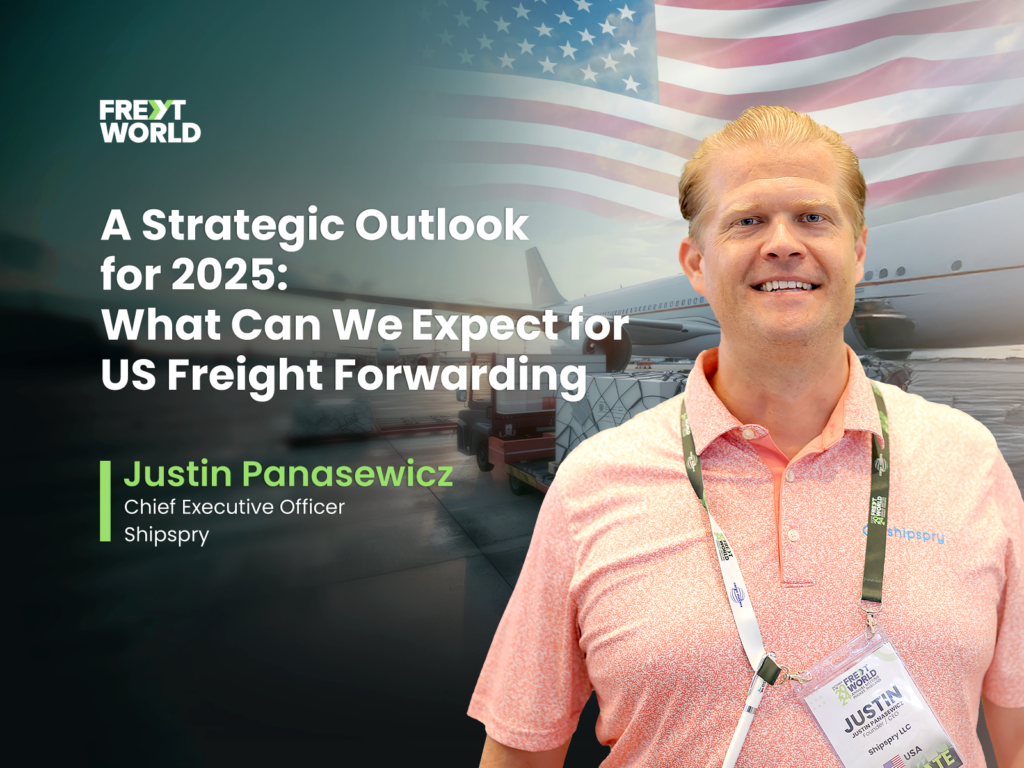By Justin Panasewicz, CEO, Shipspry LLC

As we welcome 2025, the U.S. logistics sector stands at a crucial juncture, influenced by a mix of technology, consumer needs, and shifting regulations. This year is full of both opportunities and challenges. By staying closely connected to market trends and developments, our team at Shipspry ensure we remain competitive and operationally excellent, ready to face and overcome these new developments.
Resolving the U.S. Port Strikes: A Catalyst for Stability and Innovation
A critical element on our immediate horizon is the anticipated conclusion of the prolonged U.S. port strike. This standstill has significantly impacted economic activity, underscoring the urgency of delivering a resolution. Expected to conclude in January, the end of this strike represents not only an opportunity to stabilize supply chains but also a moment to critically reassess our relationships with port operations. More than ever, it is important for us freight forwarders to build adaptable and resilient logistical strategies that can deftly navigate future disruptions.
Economic Trends and Market Dynamics: Steering Through Headwinds
United States logistics is expected to experience moderate growth in 2025. According to Fitch Ratings, the outlook for the U.S. and Canadian freight transportation and logistics sector is neutral. The U.S. economy is projected to grow steadily, driven by consumer spending and industrial production. This growth is driven by consistent consumer demand and industrial production, though both are moderated by ongoing pressures. As the trucking industry adjusts its capacity, leading to higher transportation costs, our strategic planning will need to prioritize efficiency and resource management.
Harnessing Technology and Automation
The integration of automation and AI in logistics is no longer a future vision—it’s our current reality. Industry projections anticipate that over 60% of supply chain firms will make substantial investments in IoT and real-time analytics by the end of this year. We, at Shipspry, are actively incorporating AI into our logistics processes. By emphasizing predictive analytics and fleet optimization, we are trailblazing new standards in transparency and efficiency that align with current market expectations.
However, increased digitization brings its own set of challenges. Cybersecurity will be a critical concern as logistics companies become more reliant on digital systems. Protecting sensitive data and ensuring the integrity of supply chain operations will be paramount. Companies that invest in robust cybersecurity measures will be better positioned to navigate the complexities of the digital landscape.
Sustainability: Aligning with Future Demands
Nowadays, sustainability is not just a mere trend; it's a necessity. Consumer expectations now rely on environmental responsibility, and our industry must align accordingly. The Environmental Protection Agency highlights transportation emissions as a core concern, pushing us towards cleaner operations.
Freight forwarders need to not only comply with these sustainability demands but actively pursue partnerships that support eco-friendly initiatives. Investing in renewable energy solutions isn’t optional—it’s an imperative. Meeting these expectations not only enhances our industry stature but also opens doors to government incentives and new market segments.
Strategic Considerations for Freight Forwarders
Considering the current trends, freight forwarders need to take a proactive stance to effectively navigate the challenges and capitalize on the opportunities that 2025 presents. Here are some strategic considerations:
Diversify Supply Chains: To avoid problems from disruptions, companies should use different supply routes and transportation methods to keep things running smoothly.
Invest in Technology: Using advanced tech like AI, predictive analytics, and blockchain can make operations more efficient and give a competitive edge. It's also important to invest in cybersecurity to protect against digital threats.
Build Strong Partnerships: Creating good relationships with carriers, shippers, and other partners is crucial. Working together can make supply chains more resilient and flexible.
Focus on Sustainability: With growing environmental concerns, freight forwarders should adopt greener practices and technologies to reduce their carbon footprint.
2025: Embracing Adaptability and Innovation
The outlook for U.S. Freight Forwarding in 2025 is one of cautious optimism. While economic growth and technological advancements present significant opportunities, challenges such as the port strike and cybersecurity threats cannot be overlooked. By adopting a strategic and proactive approach, freight forwarders can navigate these complexities and position themselves for success in the year ahead.
As the year progresses, we find ourselves on the brink of significant change, driven by strategic technology investments, improved supply chain visibility, and proactive regulatory management. For my colleagues across the logistics landscape, I encourage a continued exchange of insights and strategies. We must cultivate a resilient and responsive ecosystem, equipped to tackle the uncertainties of our global market. At Shipspry, we remain committed to leading this ongoing dialogue and paving the way for sustained success in the freight forwarding industry.
Freyt World Blog Contributor
Freyt World is a global logistics network uniting members from around the world. Our mission is to revolutionize global logistics through collaboration and innovation. Our platform goes beyond networking, enabling members to excel and grow together, featuring articles by logistics professionals for their peers. This series will cover industry-relevant issues and news, providing valuable insights for professionals in the field.



